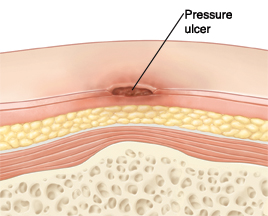Pressure Injury

A pressure injury (decubitus ulcer) starts as a red, tender area on skin (pressure sore). It's caused by lying or sitting on a bony area for long periods of time without changing your position. This reduces the amount of blood flow to that part of the skin. Pressure injuries often occur on the lower back, buttocks, or heels. They affect people who spend most or all their time in bed. These pressure injuries take a long time to heal, depending on how big they are and how deep they are.
If a pressure injury becomes infected, it will cause redness in the skin around the pressure injury. Pus will drain from the wound. If not treated early, an infection from a pressure injury can spread to the bloodstream or nearby bone.
Home care
Follow these guidelines to help you or your caregiver care for your wound at home:
-
Look at your pressure injury every day with good lighting to watch for signs of infection. At the same time, check other skin pressure points for early signs of skin changes.
-
Change positions at least every few hours. It will let blood flow to the pressure areas. This is essential for healing to occur. A foam, water, or air mattress or gel pad will help reduce the pressure on the skin.
-
Your health care provider may give you a special skin covering that stays in place on the pressure injury. If a simple bandage is used, change it daily. Clean the pressure injury with sterile saline or another solution your provider tells you to use. Pat dry. Apply any prescribed lotion or cream. Cover with a clean, dry gauze pad.
-
Bed linens should be kept clean and dry.
-
Try to keep from soiling the pressure injury with feces or urine. If this isn’t possible, try to limit the time of contact with the feces or urine. Do this by keeping the wound covered and clean.
Follow-up care
Follow up with your health care provider as advised.
When to get medical advice
Contact your health care provider right away if:
-
There is redness or darkness around the wound that gets worse.
-
There is pain or swelling near the wound that gets worse.
-
Pus drains from the wound.
-
There is foul or increasing odor from the wound.
-
The wound does not get better.
-
You have an unexplained fever of 100.4°F (38°C) or higher, or as directed by your provider.
Online Medical Reviewer:
Esther Adler
Online Medical Reviewer:
Stacey Wojcik MBA BSN RN
Date Last Reviewed:
3/1/2025
© 2000-2025 The StayWell Company, LLC. All rights reserved. This information is not intended as a substitute for professional medical care. Always follow your healthcare professional's instructions.